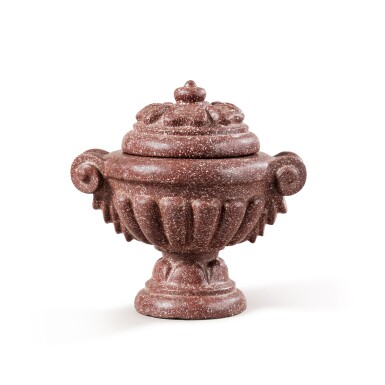Un autre regard : Collection Edric van Vredenburgh, Part I
Un autre regard : Collection Edric van Vredenburgh, Part I

An Egyptian porphyry vase and cover, Italy or France, circa 1700 | Vase couvert en porphyre égyptien, Italie or France, vers 1700
Auction Closed
April 13, 03:37 PM GMT
Estimate
20,000 - 30,000 EUR
Lot Details
Description
An Egyptian porphyry vase and cover, Italy or France, circa 1700
the scalloiped lid above a gadrooned body with scrolling handles and stepped motif, on a tapering gadrooned circular socle
Height 10¼in; width 10¼in; diam 7½in
__________________________________________________________________________
Vase couvert en porphyre égyptien, Italie or France, vers 1700
à décor godroné reposant sur une base circulaire, les poignées ornées de volutes
Haut. 26 cm, larg. 26 cm, diam. 19 cm
Purchased from Sir Martin Wilson Bt., 1972.
__________________________________________________________________
Acheté à Sir Martin Wilson Bt., 1972.
Of elegant shape, and finely carved motifs, this striking vase reflects the ever-enduring appeal in France of Egyptian porphyry, which as a material symbolizing wealth, power and luxury, stopped being quarried in Ancient times, and its use from the Renaissance onwards was mainly made possible by reclaiming the material from Ancient Roman monuments, ruins, and particularly columns. The vase follows a model which combines the weightiness of unadorned sections with the dynamism of gadrooned and scrolled sections and of the roundels beneath the handles, the whole with several degrees of depth and boldness of carving. Whilst it presents the traditional Roman straight gadrooning, the leaf-carved lid and the carved roundels beneath the handles are quite original and inventive and altogether the vase would have certainly caught the eyes of a collector in the late 17th century/early 18th century.
Porphyry during the reign of Louis XIV enjoyed great interest from collectors of the time such as Richelieu, Mazarin and of course King Louis XIV himself. During the second half of the 17th century, correspondence attests to the large amount of purchases of porphyry vases intended for the French Royal collections. Indeed, Father Benedetti (circa 1610 – 1690), the Roman agent to Cardinal Mazarin, who first served as an intermediary, and then became the direct agent to the King of France after Cardinal Mazarin died, drew several designs for porphyry vases which were either already available, or indeed ordered in Rome for French customers. Increasingly, the traditional Roman forms and models with straight or twisted gadrooning started to include varied motifs and even fantastical and figural motifs as to cater the French taste. Related porphyry vases of similar dimensions are illustrated in Dario Del Bufalo, Porphyry. Red imperial porphyry. Power and religion, Allemandi, 2012, p.145, V46 p. 151, ref. V94. A related vase with a leaf carved lid and body is in the collections of the Marquess of Carpio (see drawing in A. González-Palacios, Las colecciones reales españolas de mosaicos y piedras duras, Madrid, 1990, p. 35).
De forme élégante, aux motifs finement sculptés, ce vase remarquable reflète l'attrait toujours renouvelé en France pour le porphyre égyptien, matériau symbolisant la richesse, le pouvoir et le luxe, dont l'extraction a cessé dans l'Antiquité, et dont l'utilisation à partir de la Renaissance a été rendue possible principalement par la récupération du matériau sur des monuments, des ruines et surtout des colonnes de la Rome antique. Le vase suit un modèle qui combine la légèreté des sections non ornées avec le dynamisme des sections à godrons et à volutes ainsi que des rondelles sous les poignées, le tout avec plusieurs degrés de profondeur et d'audace dans la sculpture. Alors qu'il présente le traditionnel godron droit romain, le couvercle sculpté de feuilles et les rondelles sculptées sous les poignées sont tout à fait originaux et inventifs ce qui aurait certainement attiré l'attention d'un collectionneur à la fin du XVIIeme siècle/début du XVIIIeme siècle.
Sous le règne de Louis XIV, le porphyre a suscité un grand intérêt de la part des collectionneurs tels que Richelieu, Mazarin et bien sûr le roi lui-même. Durant la seconde moitié du XVIIeme siècle, la correspondance atteste de l'importance des achats de vases en porphyre destinés aux collections royales françaises. En effet, le père Benedetti (vers 1610-1690), l'agent romain du cardinal Mazarin, qui a d'abord servi d'intermédiaire, puis est devenu l'agent direct du roi de France après la mort du cardinal Mazarin, a dessiné plusieurs modèles de vases en porphyre qui étaient soit déjà disponibles, soit commandés à Rome pour des clients français. De plus en plus, les formes et les modèles romains traditionnels à godrons droits ou torsadés ont commencé à inclure des motifs variés et même des motifs fantastiques et figuratifs pour répondre au goût français. Des vases en porphyre de dimensions similaires sont illustrés dans Dario Del Bufalo, Porphyry. Porphyre impérial rouge. Pouvoir et religion, Allemandi, 2012, p.145, V46 p. 151, ref. V94. Un vase analogue, dont le couvercle et le corps sont sculptés de feuilles, se trouve dans les collections du marquis de Carpio (voir le dessin dans A. González-Palacios, Las colecciones reales españolas de mosaicos y piedras duras, Madrid, 1990, p. 35).
